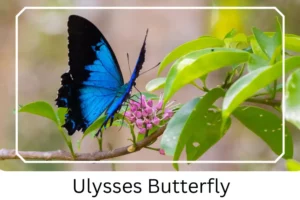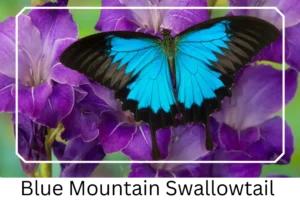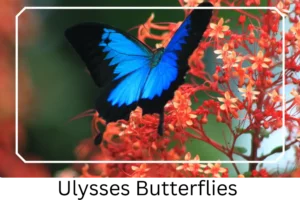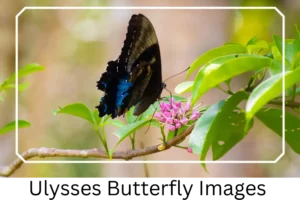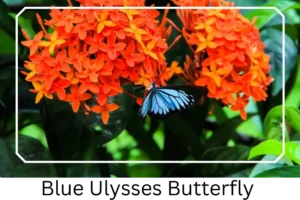Ulysses (Papilio Ulysses)
The Ulysses butterfly, named after the Greek hero Ulysses from the epic Odyssey, is a magnificent swallowtail butterfly renowned for its vibrant colors and dynamic presence. Predominantly found in and around Australia, this species’ electric blue hues make it one of the most visually striking butterflies in existence. The allure of the Ulysses butterfly extends beyond its appearance, embodying fascinating behaviors and lifecycle stages that captivate enthusiasts and researchers alike.
Scientific Classification
- Family: Papilionidae
- Genus: Papilio
- Common names: Blue Emperor
- Scientific Name: Papilio Ulysses
Overview
Thriving in a variety of environments from suburban gardens to tropical rainforests, the Ulysses butterfly exhibits a remarkable adaptability that contributes to its widespread distribution across Eastern Queensland, New Guinea, and other Pacific islands. The lifecycle of this butterfly, from egg to adult, showcases nature’s intricacies and the delicate balance of ecosystems. Beyond its beauty, the Ulysses butterfly plays a significant role in promoting biodiversity and ecological awareness.
Description and Identification
Caterpillar
The Ulysses butterfly caterpillar undergoes a significant transformation through its development stages. Initially, they exhibit a yellowish-green color with a distinctive pair of spikes on each back segment and a notable black mark around the middle section. As they mature, the caterpillars adopt a white and green coloration, blending seamlessly with the foliage of their host plants, primarily the Euodia genus and kerosene wood, ensuring effective camouflage against predators.
Pupa
The pupa stage of the Ulysses butterfly, or chrysalis, measures approximately 1.57 inches (4 cm) in length and is green, harmonizing with the surrounding vegetation. It remains suspended from the food plant in a secure position until the metamorphosis into an adult butterfly is complete.
Adult Butterfly
Sexual Dimorphism: Females display distinctive little blue crescents on the back of their upper wings, while males possess a sleek entirely black coloration. Both sexes boast elongated and extended tails at their wingtips, adding to their elegant appearance.
Color and Appearance: In flight, the adult butterfly reveals its breathtaking bright electric blue wings bordered by stark black. The forewings are adorned with characteristic thin black lines, enhancing their striking visual appeal. When wings are folded, the butterfly assumes a more inconspicuous black and brown coloration, providing camouflage against predators.
Average Wingspan: The Ulysses butterfly boasts an impressive average wingspan of 5.5 inches (14 cm), contributing to its majestic presence.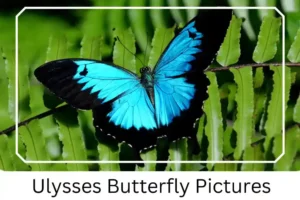
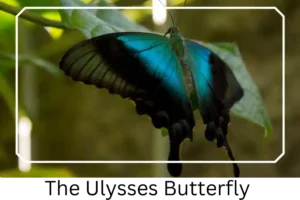
Flight Pattern: Characterized by a fast and erratic flight pattern, the Ulysses butterfly is a dynamic flyer, able to navigate swiftly through various habitats.
Eggs
The spherical, white eggs of the Ulysses butterfly are laid individually on the leaves of their food plants. As the butterfly eggs mature, they darken, signaling readiness to hatch. Females exhibit a preference for laying eggs on shorter plants, enhancing the visibility and survival rate of the offspring.
Quick Facts | |
| Distribution | Eastern Queensland, New Guinea, Bismarck Archipelago, the Moluccas, and the north-western Solomon Islands. |
| Habitat | Suburban gardens and tropical rainforests. |
| Lifespan of Adults | Ranges from a week to several months, with the maximum lifespan around 8 months. |
| Host Plants | Plants of the Euodia genus and kerosene wood. |
| Adult Diet | Blossoms of pink flowered doughwood. |
How to Identify Ulysses Butterfly?
Identifying a Ulysses butterfly in its natural habitat can be a delightful experience, with several key features to look for. Adult butterflies are most recognizable by their vibrant electric blue wings with black borders, visible when in flight. The presence of long, extended tails at the bottom of their wings and the distinctive black lines along the forewings are also indicative of the species. Caterpillars can be identified by their green and white camouflage, along with the unique spikes and black mark on their back. Observing these characteristics, along with the butterfly’s erratic flight pattern, can help enthusiasts and researchers alike to spot and appreciate this magnificent creature.
Did You Know?
- Male Ulysses butterflies are attracted to the blue crescents on the female’s wings, often mistaking anything blue for a potential mate.
- The Ulysses butterfly serves as an emblem for Queensland, Australia, symbolizing the region’s natural beauty and biodiversity.
- The butterfly’s bright colors not only mesmerize onlookers but also serve as a warning to predators about their potential toxicity.
Conclusion
The Ulysses butterfly is not just a symbol of natural beauty but also an important part of its ecosystem, contributing to the pollination of various plants. Its vibrant colors and dynamic life cycle have made it a subject of fascination and study. By understanding and appreciating the intricacies of its existence, we can better appreciate the importance of biodiversity and the need to protect natural habitats.
Ulysses Butterfly Pictures

Scientific Classification

- Family: Papilionidae
- Genus: Papilio
- Common names: Blue Emperor
- Scientific Name: Papilio Ulysses

